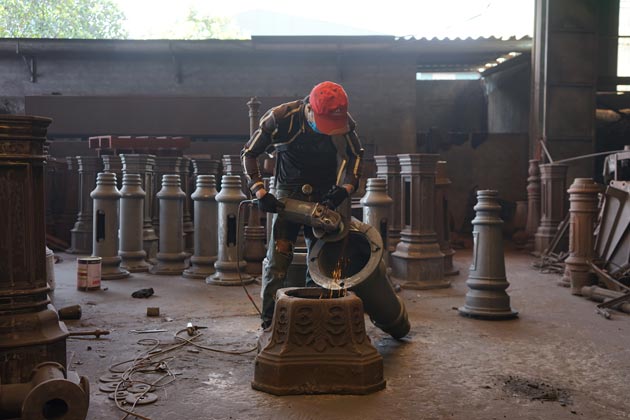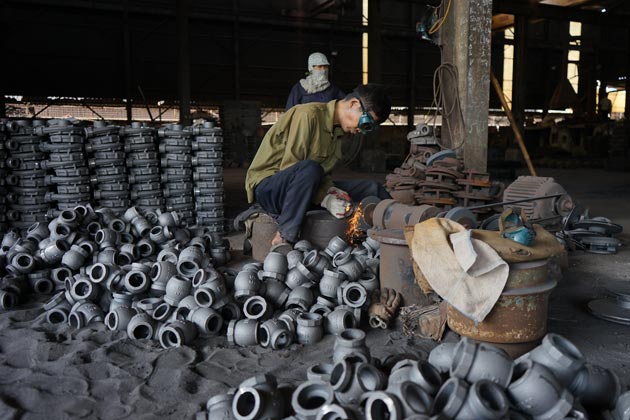Aluminum Foundry Wisconsin remains a reliable partner in casting solutions
Exactly How Aluminum Foundry Contributes to Innovations in Aerospace Engineering
Aluminum shops are important to advancements in aerospace design. They produce lightweight, high-strength elements that are necessary for modern-day aircraft. With innovative casting techniques, these foundries develop intricate geometries that enhance architectural stability. In addition, the advancement of remarkable Aluminum alloys sustains the market's emphasis on gas efficiency and sustainability. Nevertheless, obstacles continue to be in the manufacturing procedure. Comprehending these aspects reveals the extensive impact of Aluminum on aviation's future.
The Relevance of Lightweight Products in Aerospace Layout
As the aerospace market remains to evolve, the significance of lightweight products comes to be significantly obvious. The demand for efficiency and sustainability drives engineers to prioritize making use of materials that minimize general weight without endangering structural stability. Light-weight materials, particularly Aluminum, play an essential role in boosting gas performance, enhancing payload capability, and enhancing the general performance of airplane.
The integration of these materials permits for ingenious designs, making it possible for suppliers to produce more aerodynamic shapes that can stand up to extreme conditions. The reduction in weight not just reduces functional costs but additionally contributes to a decreased environmental footprint, lining up with global initiatives toward sustainability in aviation.
Advanced Casting Techniques in Aluminum Foundries
Advanced casting methods in Aluminum shops play an essential role in aerospace engineering by making it possible for the manufacturing of light-weight and precise parts. Developments in mold and mildew layout and precision casting procedures are important in attaining excellent performance and structural integrity. Furthermore, the growth of lightweight alloys enhances the overall performance and efficiency of aerospace applications.
Ingenious Mold And Mildew Design
Cutting-edge mold and mildew design plays a crucial duty in the effectiveness and performance of Aluminum shops, particularly within the aerospace field. By leveraging advanced materials and techniques, contemporary mold and mildews can be engineered to withstand high temperature levels and pressures, ensuring peak performance throughout the casting procedure. These styles usually integrate complex geometries that allow for the production of light-weight yet structurally audio components, essential for aerospace applications. In addition, using computer-aided layout (CAD) software application helps with accurate modeling, enabling foundries to improve and mimic mold layouts prior to physical manufacturing starts. This not just enhances the top quality of actors components but likewise lowers waste and preparation, resulting in substantial expense savings. Overall, cutting-edge mold and mildew style is a cornerstone of development in Aluminum Foundry innovation for aerospace design.
Accuracy Casting Procedures
The performance of cutting-edge mold designs flawlessly incorporates with precision spreading procedures, which are vital for creating top notch Aluminum parts in aerospace engineering. These processes, consisting of sand spreading, die casting, and investment casting, ensure the production of complicated geometries with limited tolerances. Advanced strategies like vacuum casting and stress pass away casting enhance the honesty and surface coating of the last products. Accuracy spreading minimizes product waste while optimizing the mechanical homes of Aluminum, critical for aerospace applications. Furthermore, employing real-time monitoring and advanced simulation devices during the spreading procedure permits prompt changes, causing enhanced high quality control. Jointly, these accuracy casting procedures setting Aluminum factories at the center of aerospace technology, supporting the industry's demand for dependability and performance.
Light-weight Alloy Growth
As aerospace designers look for to enhance gas performance and performance, light-weight alloy advancement becomes an important focus in Aluminum shops. These shops employ advanced casting techniques to produce alloys that supply exceptional strength-to-weight ratios. Developments in alloy composition, consisting of the consolidation of components like lithium and magnesium, enable the manufacturing of products that hold up against extreme conditions while decreasing total aircraft weight. Techniques such as die spreading and financial investment casting promote the precision manufacturing of complex forms, which are crucial for aerospace applications. Furthermore, ongoing research aims to enhance these alloys for improved mechanical residential or commercial properties and enhanced durability. By prioritizing light-weight alloy development, Aluminum foundries substantially add to the advancement of aerospace design, leading the way for extra sustainable and reliable aircraft designs.

Enhancing Structural Stability Through Aluminum Components
Aluminum components supply significant benefits in improving structural stability within aerospace engineering. Their lightweight nature adds to total performance while preserving toughness, which is essential for airplane performance. In addition, the anxiety resistance homes of Aluminum assistance guarantee the longevity and reliability of aerospace structures under numerous functional conditions.
Lightweight Product Perks
While conventional materials commonly compromise weight for stamina, utilizing Aluminum components in aerospace design uses significant benefits in structural integrity. Aluminum's light-weight nature adds to general design efficiency, permitting more structured aircraft that take in much less fuel, consequently enhancing sustainability. The product's excellent strength-to-weight ratio assurances that parts keep resilience without adding unnecessary mass. This quality cultivates boosted performance and dexterity in flight, in addition to optimized payload capabilities. In addition, Aluminum's resistance to deterioration lengthens the life expectancy of aerospace frameworks, lowering maintenance costs and improving safety. As makers increasingly take on Aluminum alloys, the aerospace industry experiences a transformative change towards a lot more reliable and effective design services that focus on both performance and ecological obligation.
Tension Resistance Characteristics
Although numerous products have unique homes, Aluminum's outstanding stress and anxiety resistance stands apart as a critical consider boosting the structural stability of aerospace parts. This resistance plays a vital duty in making sure that aircraft can hold up against different operational tensions, including tiredness, effect, and ecological conditions. Aluminum alloys, particularly engineered for aerospace applications, show high tensile toughness while maintaining light-weight attributes, allowing designers to design extra effective frameworks - Aluminum Foundry. Furthermore, the capacity of Aluminum to withstand cyclic loading without substantial deformation adds important link to the durability and integrity of aerospace components. As improvements proceed in Aluminum Foundry techniques, the growth of stress-resistant Aluminum parts guarantees further enhancements in performance, safety, and performance throughout the aerospace sector, solidifying Aluminum's duty as a preferred material in modern-day design
Fuel Efficiency Improvements Driven by Aluminum Innovations
As the aerospace industry looks for to enhance gas efficiency, innovative usages of Aluminum have actually become an important service. Aluminum's lightweight nature significantly decreases aircraft weight, enabling reduced fuel usage throughout flight. This reduction in weight is important, as also small declines can cause significant improvements in total fuel economic situation.
Advanced Aluminum alloys, designed for boosted stamina and durability, allow manufacturers to create parts that maintain structural integrity while decreasing mass - Aluminum Foundry. Additionally, the assimilation of Aluminum in airframes and engine components facilitates improved aerodynamics, contributing to decreased drag and boosted performance
The fostering of Aluminum in aerospace not only meets the demand for fuel-efficient style yet likewise straightens with governing stress for lower emissions. As these developments remain to develop, they play a considerable duty in establishing brand-new criteria for fuel efficiency, making sure that the aerospace field can satisfy growing financial and ecological difficulties.

The Role of Aluminum in Sustainable Air Travel Practices
The increasing emphasis on lasting air travel methods has actually placed Aluminum as an important material in the mission for greener airplane style. Known for its lightweight residential properties, Aluminum significantly lowers airplane weight, bring about reduced gas consumption and emissions. Its recyclability further boosts its sustainability account, as Aluminum can be recycled indefinitely without loss of high quality. This characteristic sustains a round economy within the aviation field, reducing waste and resource exhaustion.
Innovations in Aluminum alloys have enhanced their stamina and deterioration resistance, enabling for longer solution life and reduced maintenance demands. These advancements assist in the growth of much more effective aircraft structures, adding to general sustainability initiatives. Additionally, Aluminum's thermal conductivity plays a critical role in energy-efficient layouts, improving systems such as heat exchangers. Collectively, great site these attributes underscore Aluminum's critical role beforehand sustainable air travel, straightening with international initiatives intended at lowering the ecological impact of air travel.
Obstacles Faced by Aluminum Foundries in Aerospace Production
While Aluminum foundries play an important duty in aerospace manufacturing, they encounter considerable challenges that can influence production performance and top quality. One major challenge is the stringent quality assurance standards called for in the aerospace sector. Any kind of flaw can jeopardize security and performance, demanding strenuous examination processes that prolong production timelines. In addition, factories frequently contend with fluctuating raw product prices, which can impact prices and earnings. The intricacy of Aluminum alloys made use of in aerospace applications more complicates the manufacturing procedure, as exact formulations are essential for accomplishing desired mechanical buildings. In addition, proficient labor scarcities prevent the ability to preserve high-quality production levels. Lastly, environmental laws impose constraints on exhausts and waste management, calling for foundries to purchase sustainable practices, which can be cost-prohibitive. These variables collectively develop a landscape where Aluminum shops should constantly adapt to fulfill the developing needs of aerospace production while guaranteeing safety and security and conformity.
Future Patterns in Aluminum Applications for Aerospace Engineering
With innovations in innovation and enhancing needs for performance, the future of Aluminum applications in aerospace engineering is poised for substantial transformation. The assimilation of innovative Aluminum alloys and compounds is anticipated to enhance strength-to-weight ratios, leading to more fuel-efficient airplane designs. On top of that, improvements in additive manufacturing techniques will certainly permit the production of complex Aluminum structures that were previously impossible, enhancing performance and lowering waste.

Lasting practices will play a vital duty, with an expanding focus on reusing Aluminum to reduce ecological impact. The aerospace industry is most likely to embrace smarter manufacturing procedures, such as automation and expert system, making sure greater quality and accuracy in Aluminum elements. Partnerships between Aluminum factories and aerospace firms will cultivate study and growth, leading the method for brand-new applications that satisfy the stringent demands of modern-day aerospace engineering. Overall, the future looks guaranteeing for Aluminum's duty fit the skies
Regularly Asked Questions
What Are the Ecological Impacts of Aluminum Manufacturing in Aerospace?
The environmental impacts of Aluminum production in aerospace consist of significant energy intake, greenhouse gas exhausts, and habitat disturbance. Additionally, mining procedures can lead to soil destruction and water contamination, raising problems about sustainability and ecological balance.
How Does Aluminum Contrast to Other Products in Aerospace Applications?
Aluminum provides a distinct mix of light-weight homes, rust resistance, and cost-effectiveness compared to other materials. Its high strength-to-weight proportion makes it specifically beneficial for aerospace applications, enhancing gas efficiency and overall performance in airplane style.
What Certifications Do Aluminum Foundry Workers Demand for Aerospace Projects?
Aluminum Foundry workers require specific training in metallurgy and spreading methods, in addition to understanding of aerospace sector criteria. Certifications in quality control and safety protocols are likewise vital to guarantee compliance with strict aerospace task needs.
Are There Any Kind Of Safety Interest In Using Aluminum in Aerospace Design?
Safety and security concerns relating additional info to Aluminum in aerospace design consist of susceptibility to anxiety, rust, and tiredness cracks. Correct therapy and alloy choice are necessary to mitigate these dangers, making certain structural stability and general safety in aerospace applications.
How Does Aluminum Recycling Benefit the Aerospace Sector?
Aluminum reusing significantly benefits the aerospace sector by reducing material prices, lessening ecological effect, and conserving power. This lasting technique improves the market's effectiveness while advertising using light-weight, high-performance elements in aircraft manufacturing.
Advanced casting strategies in Aluminum foundries play an essential function in aerospace engineering by allowing the manufacturing of lightweight and accurate elements. Cutting-edge mold and mildew layout plays an essential function in the effectiveness and effectiveness of Aluminum foundries, especially within the aerospace industry. As aerospace engineers look for to enhance fuel effectiveness and efficiency, light-weight alloy advancement becomes a vital emphasis in Aluminum foundries. Aluminum alloys, especially crafted for aerospace applications, display high tensile strength while preserving lightweight qualities, enabling designers to create extra efficient structures. Collaborations in between Aluminum foundries and aerospace companies will certainly foster research and development, leading the way for brand-new applications that meet the stringent requirements of modern aerospace design.